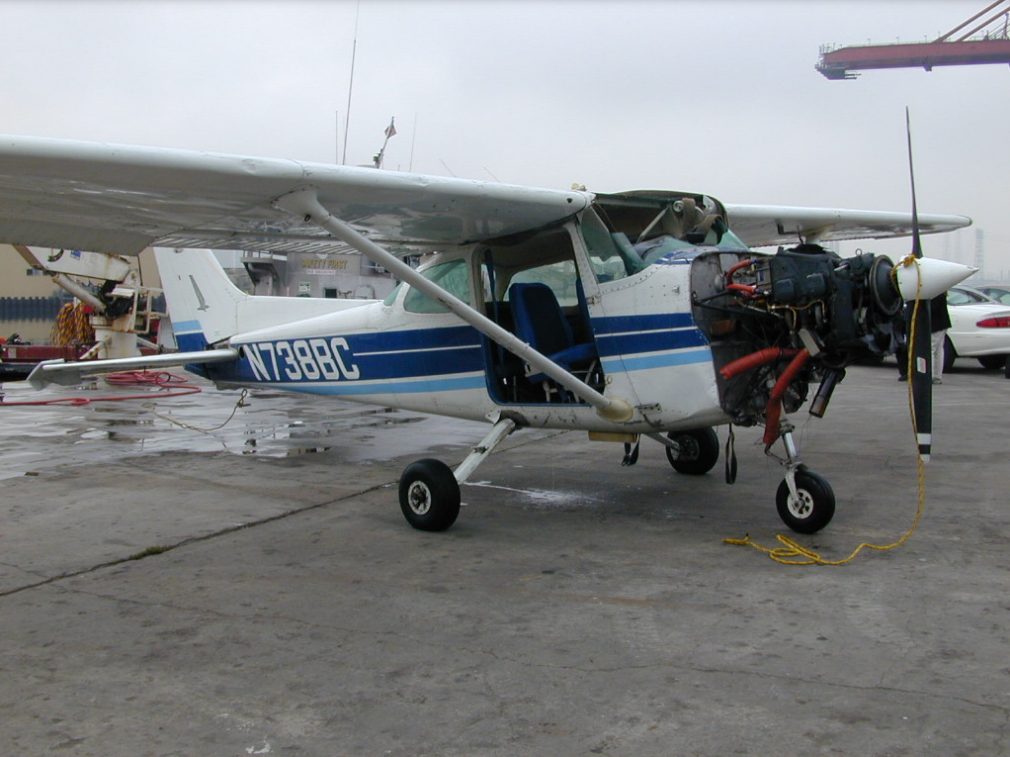
ASN Wikibase Occurrence # 45671
This information is added by users of ASN. Neither ASN nor the Flight Safety Foundation are responsible for the completeness or correctness of this information.
If you feel this information is incomplete or incorrect, you can submit corrected information.
| Date: | Tuesday 25 December 2001 |
| Time: | 15:03 |
| Type: |  Cessna 172N Skyhawk II |
| Owner/operator: | Security Aviation |
| Registration: | N738BC |
| MSN: | 17269840 |
| Year of manufacture: | 1977 |
| Total airframe hrs: | 6168 hours |
| Engine model: | Lycoming O-320-H2D |
| Fatalities: | Fatalities: 2 / Occupants: 3 |
| Aircraft damage: | Destroyed |
| Category: | Accident |
| Location: | off San Clemente Island, CA -
 United States of America United States of America
|
| Phase: | En route |
| Nature: | Private |
| Departure airport: | Carlsbad-McClellan-Palomar Airport, CA (CLD/KCRQ) |
| Hawthorne Airport, CA (HHR/KHHR) | |
| Investigating agency: | NTSB |
| Confidence Rating: |
On December 25, 2001, at 1503 Pacific standard time, a Cessna 172N, N738BC, lost engine power and ditched in the Pacific Ocean about 1/4-mile offshore from San Clemente, California. Security Aviation was operating the rental airplane under the provisions of 14 CFR Part 91. The private pilot sustained serious injuries, one passenger sustained fatal injuries, and one passenger is missing and presumed to be deceased. The airplane was destroyed. The personal cross-country flight departed McClellen/Palomar Field (CRQ), Carlsbad, California, at 1449, en route to Hawthorne (HHR), California. Visual meteorological conditions prevailed, and no flight plan had been filed. The primary wreckage was at 33 degrees 20.02 minutes north latitude and 117 degrees 30.26 minutes west longitude.
The airplane lost engine power and the pilot ditched it in the Pacific Ocean about 1/4-mile offshore. He was on the return leg of a cross-country flight and had experienced no problems with the airplane or engine on the outbound leg. The pilot did not note any anomalies during the engine run up prior to takeoff on the return leg, and thought that takeoff performance was similar to previous takeoffs with passengers on board. The pilot established the airplane in cruise at 4,500 feet and an airspeed of 90 knots on an airway about 7 miles from the shoreline. He established 2,200 revolutions per minute (rpm) and leaned for cruise. Immediately thereafter, the engine speed dropped to 1,000 rpm. He did not recall any loud noises; he just noted the loss of engine rpm. He attempted to diagnose the problem, but his efforts had no results. The engine stopped, and he made a turn towards the shore. During the glide the pilot was able to affect a restart, but the engine lost power in less than 2 minutes and the rpm never rose above 1,000. The pilot told air traffic control that he wasn't going to make it to shore, and ditched the airplane about 300 yards offshore. The pilot and the passengers exited the airplane before it sank in 70 feet of water. They were on the top of the airplane for about a minute before it sank. Local authorities rescued the pilot and recovered one victim; one victim was not recovered and is presumed to be deceased. Investigators were unable to establish magneto timing or obtain spark during the wreckage examination. Disassembly of the magneto revealed that the impulse coupling spring was fractured and separated at two places. Upon reassembly without the impulse coupling, one magneto fired on all four leads; the other magneto fired intermittently on three leads due to salt water corrosion on the contacts. Metallurgical examination revealed that the surfaces of both coupling spring fractures exhibited micro features of corrosion on the surfaces. These fractured areas appeared consistent with stress corrosion cracking. Optical and scanning electron microscope examinations of the spring pieces uncovered many areas of corrosion and corrosion pitting on the spring surfaces. The corrosion pitting was particularly evident on the edges of the springs, but other corrosion areas were visible on the flat faces of the spring. A broken spring could retard the magneto timing to top dead center or after (the specified timing is 25 degrees before top dead center). The engine logbooks showed that the magneto inspections required in Airworthiness Directive 96-12-07 had been complied with. Examination of the airframe and the rest of the engine found no evidence of an anomaly that would have contributed to a loss of engine power.
Probable Cause: a loss of engine power due to a loss of magneto to engine timing resulting from stress corrosion crack induced fracture, and separation of the magneto impulse coupling spring.
Accident investigation:
 |
|
Sources:
NTSB: https://www.ntsb.gov/_layouts/ntsb.aviation/brief.aspx?ev_id=20020103X00014&key=1
Location
Images:

Photo: NTSB
Revision history:
| Date/time | Contributor | Updates |
|---|---|---|
| 28-Oct-2008 00:45 | ASN archive | Added |
| 21-Dec-2016 19:24 | ASN Update Bot | Updated [Time, Damage, Category, Investigating agency] |
| 10-Dec-2017 13:28 | ASN Update Bot | Updated [Operator, Departure airport, Destination airport, Source, Narrative] |
| 09-Jul-2023 06:55 | Ron Averes | Updated [[Operator, Departure airport, Destination airport, Source, Narrative]] |
| 28-Jul-2023 05:56 | Captain Adam | Updated [[[Operator, Departure airport, Destination airport, Source, Narrative]]] |
Corrections or additions? ... Edit this accident description
The Aviation Safety Network is an exclusive service provided by:


 ©2024 Flight Safety Foundation
©2024 Flight Safety Foundation